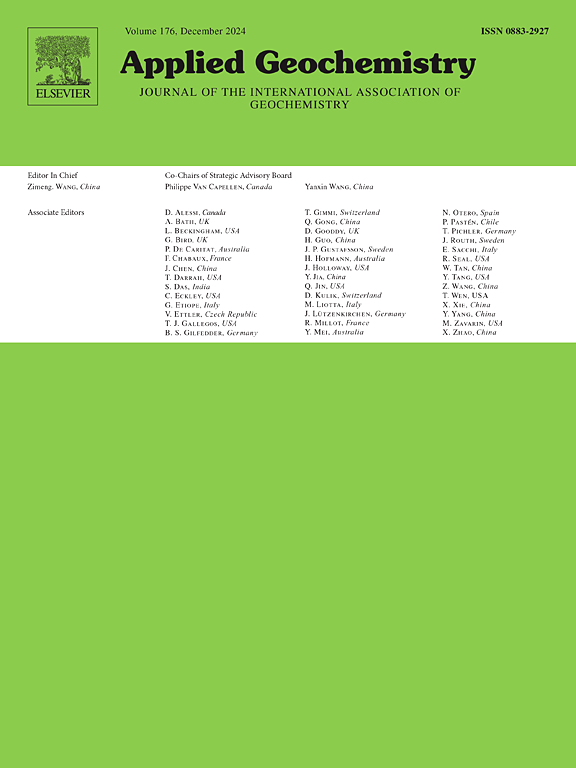An experimental and modeling study of CaCO3 nucleation and inhibition by PAPEMP under a regime of increasing oversaturation with implications for crystallization and scale formation
IF 3.1
3区 地球科学
Q1 GEOCHEMISTRY & GEOPHYSICS
引用次数: 0
Abstract
Rising saturation causes nucleation in natural and engineered environments. As the saturation increases, nucleation begins, forming a scale that is detrimental to energy production, desalination, and other industrial procedures. Inhibitor addition for scale prevention is a common practice with significant economic and environmental costs. Traditional experiments to determine induction times (tind) and evaluate inhibitor efficiency are performed under constant oversaturation. Similarly, constant oversaturation is used in both the empirical and the classical nucleation theory modeling schemes used for scale prediction. Subsequently, experiments and models do not address the dynamic nature of oversaturation increase during energy production.
We developed an experimental system for quantitative investigation of nucleation kinetics under a regime of dynamic oversaturation and a simple algorithm for determining tind from laser measurements. Using our system, we studied the precipitation kinetics of CaCO3 minerals at a pH of ∼6.76, ionic strength of I = 1 m, temperature range of 50–90 °C, and varying rates of oversaturation increase (i.e., characteristic times). We quantified the effect of a potent inhibitor (Polyamino Polyether Methylene Phosphonate; PAPEMP) on the tind and the forming solid phase. Finally, we show that the characteristic time controls tind in systems with rising supersaturation and developed a numerical model that explicitly accounts for this key parameter.
Here, we present our experimental system, results, and modeling scheme. We show that for a given set of conditions, calcite induction occurs at a similar oversaturation, regardless of the rate at which oversaturation increases. Moreover, we show that PAPEMP retards CaCO3 nucleation at below ppm levels and that it has a temperature-dependent effect on polymorphism. Lastly, we suggest that expanding existing models such that:
where f(ΔSI) is a function of oversaturation with time and f(tind, constant) are existing modeling schemes, adequately describe the dynamic nature of oversaturation and show a form of f(ΔSI) that provides an excellent fit with measured tind.
实验和模型研究了在过饱和增加的情况下,PAPEMP对CaCO3成核和抑制作用对结晶和结垢的影响
在自然和工程环境中,饱和度升高会导致成核。随着饱和度的增加,开始成核,形成对能源生产、海水淡化和其他工业过程有害的规模。为了防止结垢而添加缓蚀剂是一种常见的做法,具有显著的经济和环境成本。传统的确定诱导次数(tind)和评估抑制剂效率的实验是在恒定过饱和条件下进行的。同样,在用于尺度预测的经验和经典成核理论建模方案中都使用了恒定过饱和。随后,实验和模型没有解决能源生产过程中过饱和增加的动态性质。我们开发了一个实验系统,用于在动态过饱和状态下定量研究成核动力学,并开发了一个简单的算法,用于从激光测量中确定温度。使用我们的系统,我们研究了CaCO3矿物在pH = 6.76,离子强度I = 1 m,温度范围50-90°C和不同过饱和增加速率(即特征时间)下的沉淀动力学。我们量化了一种有效的抑制剂(聚氨基聚醚亚甲基膦酸酯;PAPEMP)在趋势和形成固相。最后,我们证明了特征时间在过饱和上升系统中的控制作用,并建立了一个明确考虑这一关键参数的数值模型。在这里,我们介绍了我们的实验系统,结果和建模方案。我们表明,在给定的一组条件下,方解石诱导发生在类似的过饱和,而不管过饱和增加的速率。此外,我们发现PAPEMP在低于ppm水平时阻碍CaCO3成核,并且它对多态性具有温度依赖性。最后,我们建议扩展现有模型,使:tind=f(ΔSI)∗f(tind,常数),其中f(ΔSI)是过饱和随时间的函数,f(tind,常数)是现有的建模方案,充分描述过饱和的动态性质,并显示f(ΔSI)的形式,它提供了与测量的tind的极好拟合。
本文章由计算机程序翻译,如有差异,请以英文原文为准。
求助全文
约1分钟内获得全文
求助全文
来源期刊

Applied Geochemistry
地学-地球化学与地球物理
CiteScore
6.10
自引率
8.80%
发文量
272
审稿时长
65 days
期刊介绍:
Applied Geochemistry is an international journal devoted to publication of original research papers, rapid research communications and selected review papers in geochemistry and urban geochemistry which have some practical application to an aspect of human endeavour, such as the preservation of the environment, health, waste disposal and the search for resources. Papers on applications of inorganic, organic and isotope geochemistry and geochemical processes are therefore welcome provided they meet the main criterion. Spatial and temporal monitoring case studies are only of interest to our international readership if they present new ideas of broad application.
Topics covered include: (1) Environmental geochemistry (including natural and anthropogenic aspects, and protection and remediation strategies); (2) Hydrogeochemistry (surface and groundwater); (3) Medical (urban) geochemistry; (4) The search for energy resources (in particular unconventional oil and gas or emerging metal resources); (5) Energy exploitation (in particular geothermal energy and CCS); (6) Upgrading of energy and mineral resources where there is a direct geochemical application; and (7) Waste disposal, including nuclear waste disposal.
 求助内容:
求助内容: 应助结果提醒方式:
应助结果提醒方式:


